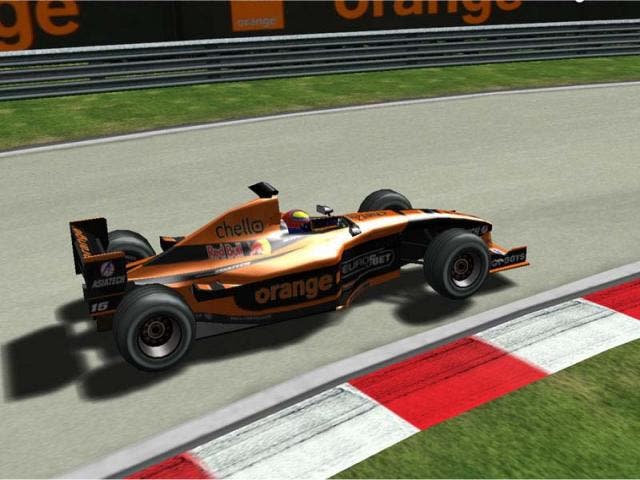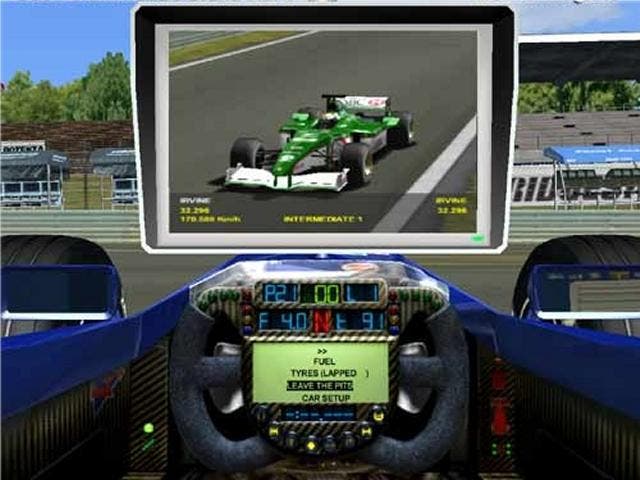Grand Prix 4
Review - concluding F1 week, Mugwum buckles up with an old friend
Battle Royale
When Geoff Crammond delivered Grand Prix 3 two years ago, his team was criticized by certain sections of the press for not doing to Grand Prix 2 what Grand Prix 2 had done to Grand Prix, and some will argue that this fourth incarnation of the famous series is guilty of the same thing. Some have even argued (pre-emptively) that EA's F1 2002 is the current king of the road, and that Crammond's crown has been displaced.
Well I've been waiting a long time for this one, and while my opinion of F1 has changed dramatically since the last game (the sport currently rests somewhere between horse-racing and guttural belching competitions on my list of things I'd like to watch), Crammond's conviction hasn't wavered in the slightest, and despite a strong challenger in the shape of F1 2002, and despite only featuring the 2001 season date, and despite an almost constant stream of cynicism from the media, Grand Prix 4 proves that it takes more than a few expensive licensing deals and a slick interface to make a good F1 game.
The first thing that catches the player's attention about GP4 is the new menu system, and it serves as a microcosm for the rest of the game. The menus in GP4 have been completely updated - answering a major criticism of GP3 - such that the player is never more than a few clicks from the track, and yet they still retain the basic structure of old, such that veterans like myself can pick it up quickly and easily.

Engine Improvements
More exciting though is the totally new in-game graphics engine, pushing more polygons than ever before. More polygons means more subtlety and variation in what's on display, and Crammond's team hasn't been afraid to reach for top-tier performance options like full transform and lighting, full scene anti-aliasing, and the full array of environment-mapped real-time shadows, environment-sourced reflections and a raft of different effects depending on the weather. Heat haze is even more obvious and effective than before, and if you've ever driven down a dusty road on a hot summer's day you will be in awe of Crammond's replication of the effect. F1 2002 had a great water-streaking effect and some other trinkets, but GP4 has an authentic environment.
Improvements to the accuracy of the game are bounteous to say the least. The 17 tracks of the GP circuit have been modelled based on photographs, video footage and Global Positioning Satellite data, and now boast varying track width and curb design - which makes overtaking more difficult - as well as the full complement of background buildings and scenery, from popular landmarks like the swimming pool section at Monaco to the less conspicuous out-buildings of Silverstone and Melbourne. Even the papier-mâché crowds have been replaced with spiffier models. Completing the picture, the pit crews and track marshals are all motion-captured and polygonal, and while I'm not a big fan of motion capture, they all look incredibly smooth and the mocap doesn't interfere with the convincing effect.
Presentation overall is very clear and the screen is rarely what you would call cluttered. Instead the developer has filled the game with handsome touches, like your having to watch TV views of the other drivers' qualifying laps on a pit monitor with their hulking racers speeding past in the background. It's all very atmospheric.

Racing costs
On the track it's a similar story. Each team now boasts its own car shape, which is a definite improvement - players won't have to wait for amateur design updates this time out. You can drive from numerous camera angles, including the new T-bar camera (although I defy you to complete a whole race with it), and the interior of the car is lined with gadgets and keeps you up to date on the status of your car. Your radioman helps with that too of course, which reminds me...
I didn't even consider the game's sound effects for several days because - to be honest - playing GP4 felt like watching F1 on television, or, if I boosted the volume, like watching F1 balanced on the nosecone of a Ferrari. Some will complain about the lack of race commentary - and it's something for Crammond to consider with GP5 - but then this only occurred to me because I saw Murray Walker being interviewed on the grid at Silverstone about an hour ago, which says something in itself.
Of course, with amazing game engines come amazing system requirements, and GP4 is a real hum-dinger. If you have a fast PC (and GP4 really needs a 1GHz processor and a GeForce 3 to break 30fps), then you're okay, but you might actually find it cheaper to buy an Xbox and that version of the game than to perform the upgrades necessary to really enjoy this on a PC - the Xbox version of GP4 is due out this summer, presumably when it stops raining. However, I can't mark GP4 down too much for its over-zealous use of graphical widgets, because I don't feel that the developer has been lazy or wasteful in its application of said widgets, and GP4 can be toned down to fit slower systems.

Three-step strategy
GP's control system remains largely untouched, and remains largely untouchable. Miraculously, on a keyboard the game is both playable and enjoyable, and based on our time with a gamepad Xbox owners have nothing to fear. Give it a steering wheel and pedals though and you might as well be in the car - you can map controls for everything an F1 driver might need.
As ever the headlining gameplay mode is the full championship season, which takes you through every hair-splittingly detailed moment of every race as your preferred driver, and its considerable bedfellows on the game's front end include the returning Quick Race mode and a non-championship race weekend option. My favourite though has proved to be 'Quicklaps'. Quicklaps is an arcade-oriented mode that sets you off with a rolling start and does away with the outlap completely, and it's useful primarily for testing out your technical adjustments, or for the pundit's favourite: hot-seating fastest laps with your drunken mates! Or if you happen to be a rich driving fanatic, you can race up to seven of them on your LAN or simply race split-screen.
And so once again Geoff Crammond's Grand Prix can be catered to just about any player. If you want an arcade racer, then you can learn the ropes quickly and easily with Quicklaps and Quick Race, and then you can fight your way through a season glossing over telemetry and other such nonsense and with a full complement or a selection of driving aids deployed; from automatic braking into corners and help with the gas to automatic steering correction and even a full-on indestructible cars option. If you fancy getting your hands a bit grubbier though, then you can tinker with virtually every aspect of the car with three distinct layers of nitty gritty to tuck into, you can choose to make full use of your various practice and qualifying options, work out a good strategy to suit the weather and track design, and you can switch off all your driving aids and see if you really could keep up with Schumacher. As if all this weren't enough, once again you can pick from various AI difficulty levels, and they will hound you to the very last if you'll let them, but they know the risks too.

Conclusion
Grand Prix 4's graphical improvements were always going to grab the headlines, and deservedly so, but they aren't merely gloss to hide a tired game. Apart from the 2001 data and the hefty system requirements, I haven't a thing to say against GP4. The competition will have to step up the challenge considerably to topple GP4 - it's an almost perfect replica of Formula One.

